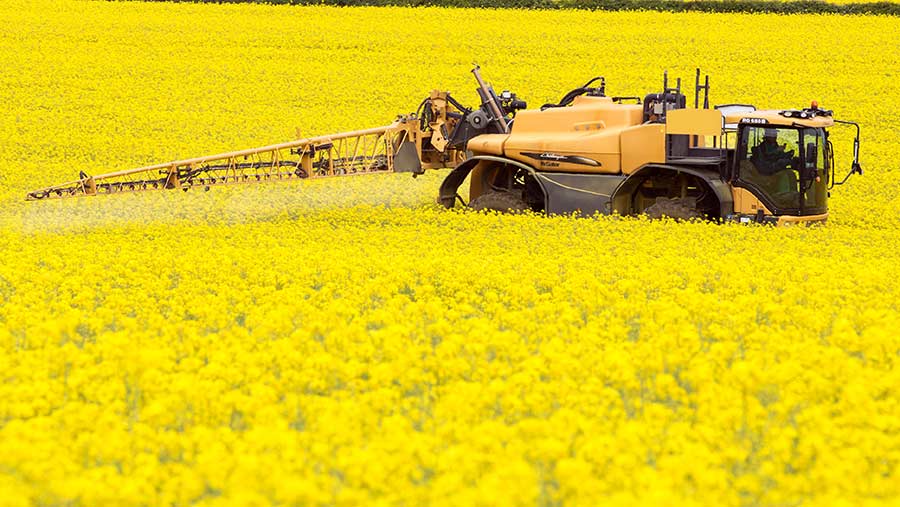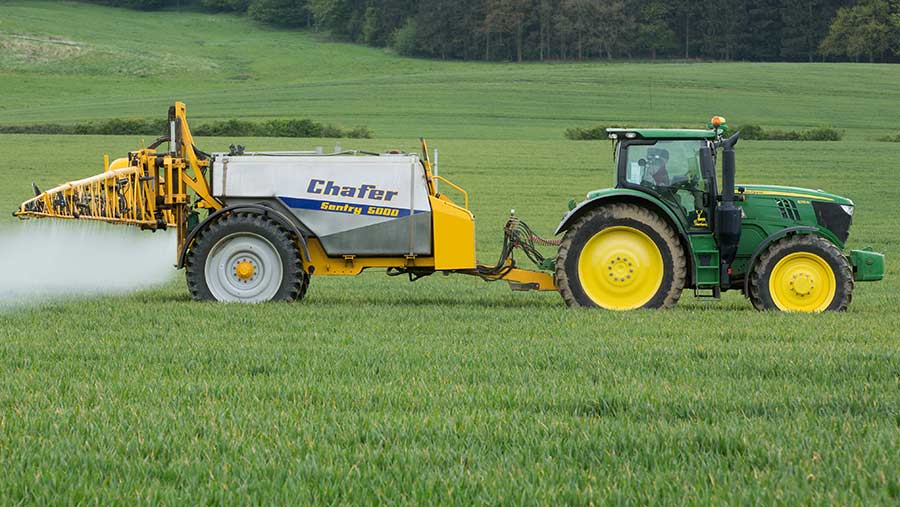Crop Watch: Sclerotinia control and yellow rust threat
 © Tim Scrivener
© Tim Scrivener Plenty of yellow rust is being seen in wheat crops, mainly in susceptible varieties. However, early thoughts from one of our agronomists is that 2019 could prove to be a yellow rust year.
Sclerotinia control in oilseed rape is also in agronomists’ thoughts, especially if the weather turns milder as fortcasted.
There are some concerns that damage caused by cabbage stem flea beetle will lead to a protracted flowering period. Damage to the main raceme has led to more branching.
North: Patrick Stephenson
AICC (Yorkshire)

Patrick Stephenson
The sad tale of oilseed rape continues, as the ravages of cabbage stem flea beetle – aided and abetted by rape winter stem weevil – are plain to see.
There appears to be some correlation in damage severity with the application of graminicides.
If they have been applied late, there is a growth check and some stem abnormalities.
This check appears to have enabled the flea beetle larvae to damage the main raceme more.
We are not quite as bad as crops to the south, but it is still a soul-destroying sight. With the main raceme dead, side branches are now being thrown out.
See also: 3 factors to consider when grazing cover crops with sheep
Management of these crops is very difficult, as the flowering period is extended, bringing sclerotinia issues.
The late flowering is very vulnerable to pollen beetle and ripening is uneven.
For the few crops that are “normal”, sclerotinia timing will be at full flowering, when we have a run of seven days with average temperatures over 11C and the all-important rainfall.
Winter wheat is a different story, as crops look full of potential. The recent strong winds and variable temperatures have certainly taken the “bloom” off the wheat, with tipping and loss of colour common.
I have advised my growers to apply part of the main dose as soon as possible, to try and keep the crops big potential.
The most difficult aspect has been making sure that you know what the correct growth stage is.

© Tim Scrivener
T1 timing
Multiple dissections later, and I am happy that T1 will be the beginning of Easter Week onwards.
My twitching bunion, which I take as a reliable indicator, tells me this is going to be a yellow rust year.
Early indications are that the Recommended List yellow rust rating is more like a form guide for the Grand National, namely you could fall at any hurdle.
Timings going forward will be critical and spray intervals will have to be watched.
Crops of Siskin, Costello, and Sundance give the most opportunity to reduce T1 spend and provide the most flexibility.
Winter barley crops also look well, having had their main nitrogen dressing in late March.
It almost seems excessive to be planning the next growth regulator, when the first has evened up the crop and slowed stem extension.
You cannot over-estimate the amount of compensatory growth that will occur as the first products lose their efficacy.
The timing for this will be at growth stage 33 and will be coupled with some chlorothalonil for ramularia control.
The hybrid crops appear to all have a weakness for brown rust and these may require an azole or strobolurin at this time.
Winter bean crops look well and, compared to the trouble and strife in the rape, they are a pleasure to walk. Flower buds are forming and there is little weevil notching.
South: Kevin Knight
Zantra (Kent)

Kevin Knight
The fluctuations and recent return to cold weather have slowed crop development down.
Given that we’re aiming for a T0 target of leaf 4 emerged, there is always an element of trading off between optimum timings for fungicides and plant growth regulators.
Early-drilled lowland wheats were covered 10 days or so back, but most of my downland wheat (and those drilled late October onwards) is only going to be ready next week.
This could leave a relatively short gap (2.5 weeks) to T1, but that’s no bad thing – and certainly better than a gap of four weeks or more if you went too early.
There’s a fair bit of yellow rust about in susceptible varieties (Zulu and Kerrin). Some was apparent in Graham six weeks back, but it seems to have abated as the plants have grown – “adult resistance” perhaps?
Patches of barley yellow dwarf virus are evident in untreated wheats. Successfully overwintering aphids will make secondary spread of barley yellow dwarf virus significant – but be mindful that there is no economic benefit to treatments after growth stage 31.
Sclerotinia
As early petals fall in oilseed rape, we don’t want the damp, foggy, days that covered last weekend.
Though risk is relatively low, monitor each crop’s development and keep an eye on sclerotinia forecasts as pressure increases.
Mildew is apparent in winter oats, so these will be receiving a treatment including mildewicide and plant growth regulator in fairly short order.
Spring beans are showing significant weevil notching despite the low temperatures and many need treating already.
Emerging spring cereals will certainly need an insecticide where threshold numbers of aphid are seen.
Given the conditions, some on marginal ground are looking peaky already, so ensure adequate nutrition and pray for timely rain and sun to get them away.
Early planted potatoes are emerging strongly and growing away, though much of the maincrop planting is just getting under way.
In the absence of Linuron, pre-emergence sprays are based around prosulfocarb (Defy), pendimethalin (Stomp) and additions of either metribuzin (Shotput), clomazone (Gamit), or metabromuron (Praxim) dependent upon weed spectrum and pressure.
There are several combinations and/or sequences that work well – but it certainly is easy to bust the spray budget if you’re not keeping an eye on the numbers.
West: Giles Simpson
Pearce Seeds (Somerset)

Giles Simpson
The recent cold wet weather has slowed up the sprayers and the chemical applications have been held up.
Thankfully, all of the winter barley has been sprayed but will be due its next fungicide imminently.
They are generally quite clean but well forward, another robust plant growth regulator will be put with the fungicide to try and make sure they stay up.
The wild oats and broad-leaved weeds have been controlled already.
The winter wheat has only just received its T0 although some crops are nearing growth stage 32, the chlorothalonil used alongside an azole for T0 has done a good job, and I can see difficulties going forward with its demise.
The T1 application will be an SDHI and azole combination with some more chlorothalonil.
Trying to get the correct timings between fungicide applications is a headache, as most of my crops are sprayed by contractors who have high-capacity sprayers, but who also have a large acreage to spray on many small farms, so any bad weather can soon mean a major delay.
Sprayer hold-ups
One major problem the contractors encounter is water availability. If only all farms had a large water tank that was full when the contractor arrived on farm, it would certainly help things along.
Generally, I would say most winter cereals are 10-14 days ahead of the normal, but we are probably four weeks ahead of where we were this time last year.
With maize drilling getting ever closer and some already been drilled, I would urge everybody to keep an eye on soil temperatures.
Don’t be too impatient and wait until the temperature is 10C and rising. There are plenty of websites that monitor the soil temperature, so have a look at them.
Many have actually seen the soil temperature drop over the past two weeks due to the cold wet rain.
When drilling does start, make sure seed-beds are good and the drill is set correctly and not driven too fast and make sure the seed is being placed evenly in the ground.
It’s worth checking yourself, don’t just leave it to the drill operator. Poorly drilled maize seed is my pet hate and it can lose you huge yields.
Tip of the week
Having a large water tank that was full when the sprayer contractor arrives on farm will help things along and avoid any delays.
Giles Simpson
East: Marcus Mann
Frontier (Essex)

Marcus Mann
The season continues to progress well, with spring drilling complete and winter crops starting to move rapidly through their growth stages.
Winter wheat T0s went on in good time, combined with larger doses of nitrogen to help support growth.
Septoria levels are building in many of the more susceptible varieties, with visible symptoms on older leaves.
It is almost certain that there will be latent disease in leaves 4 and 5, which will manifest itself as temperatures increase and latent periods shorten.
If the weather becomes more unsettled over the next few weeks, the risk of infection will increase.
Targeting 60-70% emergence of leaf 3 is crucial for the T1 fungicide timing and will contribute to the success of the overall programme.
Go too early and much of leaf 3 will be left unprotected, too late and the tip of leaf 3 is likely to become infected, which will increase the threat of infecting leaf 2 and the flag leaf.
SDHI fungicides provide the main base of control, however, it is important to use appropriate rates of azole and multi-site actives to enhance and protect their efficacy.
With the disappointing news that we are to lose chlorothanlonil, it looks like the future will rely on the use of folpet and mancozeb as multisites.
Oilseed rape
Oilseed rape ranges from green bud to early flower. With milder weather predicted, it may result in conditions conducive for sclerotinia infection.
It is best to adopt a preventative approach by targeting the early flower stage before significant petal fall, around the 40% flowering stage.
Conditions for drilling sugar beet have been excellent, which will hopefully result in rapid, even establishment.
This is even more important this year, given that it is the first year since 1992 that sugar beet will be reliant on foliar insecticides to help protect yield from yellows virus.
With the recent emergency approval of Biscaya (thiacloprid), along with Teppeki (flonicamid), there are now two approved insecticides for the control of Myzus persicae.
The date on which the first aphids begin to migrate into crop along with the duration of insecticide will be drivers for the overall programme.
As and when applications are required, it would be prudent to add a biostimulant to aid rapid crop growth to the critical 12-leaf stage.

